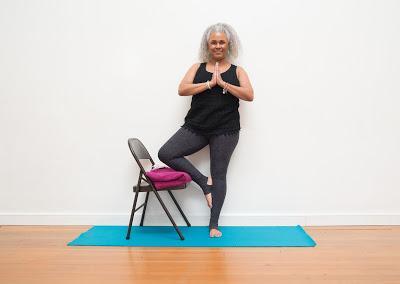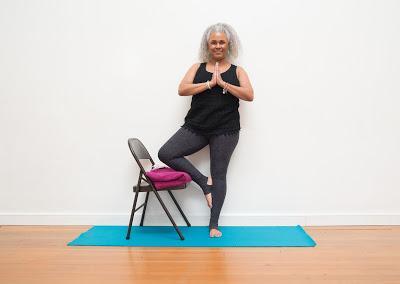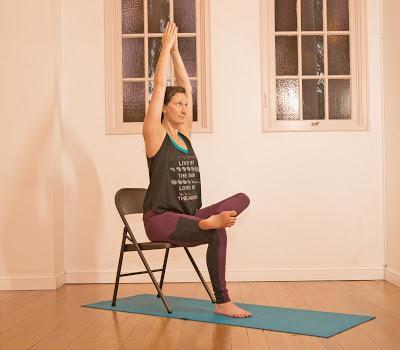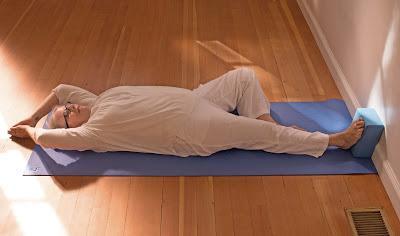
Photo by Sarit Photography
In my post The Importance of Accessible Yoga I wrote about my friend and colleague Jivana Heyman and the incredible work he is doing with his organization Accessible Yoga. Some of the things that Nina and I really appreciate about his work are the pose variations he has come up with to meet his students where they are and to make the yoga accessible to all. As a way of introducing his special perspective, I asked Jivana to share some of his Tree pose variations with us, and he kindly agreed. But before we get to that, I wanted to ask Jivana to describe the process by which these creative options came to be. Here’s what he said:"Most of the pose variations I use actually come from my students and teachers who attend my Accessible Yoga Trainings. In the training, I challenge them to explore new ways to practice. First we look at the benefits of a group of poses—why we practice them. Then we find ways to offer those same benefits in adapted forms for people of all abilities to experience yoga. I usually give the teachers a challenge, like, “show me how you would do a Sun Salutation lying in a bed.” I’ve probably led this program over forty times, and in each training someone comes up with variations of poses that I had never thought of!”
I love the fact that these variations actually came from his students’ experimentation. I often witness this happening in my classes when a student is finding that the pose variation I offered is not working for them and decides to try something a bit different to make the pose more approachable.
Now here are Jivana’s top three favorite “accessible” variations of Tree pose with his descriptions about why they are beneficial. (If you’d like to see the four variations of Tree pose that Nina and I recommend, including three versions for those who cannot practice the classic pose, see Featured Pose: Tree Pose.) Jivana concludes with some general advice about practicing these types of variations.—BaxterVariation 1: Tree Pose at the Wall with Chair

Photo by Sarit Photography
This variation is very helpful for people who need help with balance. In general, the wall is a great prop for Tree pose. Students can stand with the back against the wall or just an inch away from the wall. Then they can lean back against the wall if they feel unsteady, or move slightly away from the wall to balance on their own as they feel more balanced. The chair can offer additional help with balance and support for the raised leg, so it’s especially helpful for someone with weakness in the legs. It’s similar to the variation in your post Featured Pose: Tree Pose with the knee against the wall, but it avoids pressure on the knee. I encourage everyone who is practicing Tree pose to focus on building strength in the standing leg. This is achieved by softening the knee and engaging the muscles of that leg. Practicing with the hands in prayer position, rather than overhead, can help students focus on balance or, if more support is needed, it can be helpful to bring the arms down alongside the body and place the hands flat on the wall for support.Variation 2: Seated Tree
Photo by Sarit Photography
Practicing Tree pose while seated in a chair is a great variation for anyone who is having difficulty with balance or is unable to stand. By practicing in the chair the element of balance is removed, and the other aspects of the pose can be explored more deeply. The dynamic tension between grounding and lifting that is the hallmark of the pose can be clearly felt, with the added grounding in the sitting bones. It’s even possible to engage the muscles of the supporting leg as an isometric exercise by pressing the foot into the floor.In the variation pictured, there is also a deep hip opening. If this is too intense, the bent leg can be opened to the side with the foot resting on a block rather than on the opposite knee. Seated Tree pose can also be practiced by sitting on the floor facing a wall with one leg extended and that foot pressing into a block against the wall.Variation 3: Log Pose, or Fallen Tree
Photo by Sarit Photography
One of my favorite ways to practice and teach Tree pose is supine. Once again the element of balance is removed, so students can explore the other dynamics of the pose a little deeper. In particular, I find grounding through the foot to be powerful in this variation. This grounding experience is especially helpful for someone who needs to stay in bed for an extended period of time or is unable to stand. The foot can be actively pressed into a block against the wall (or the footboard of a bed) as if it was the floor.Also, in this position the effect of gravity on the body is quite different than when standing. Here, gravity assists in the opening of the shoulders and the hip of the bent leg. In fact, I would suggest placing a blanket or block under the bent leg to help keep the hips level and to reduce the stretch in that hip.I realize that many yoga students don’t feel confident enough in their personal practice to explore these types of variations on their own, but as teachers I think we should be encouraging it. In general, my goal is to launch students into their own personal practice where they no longer need the constant supervision of a teacher. Of course, practitioners need to be aware of their alignment, which I define as practicing safely. But bringing creativity into yoga practice can add so much! It can offer us the opportunity to practice when we are tired or injured, and it can offer us the ability to explore our bodies and what they really need in that moment. This creativity can also connect us back to the essential purpose of yoga, which is to calm the body and mind and connect with a deeper peace.—Jivana

